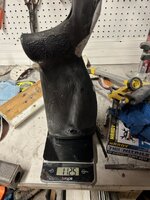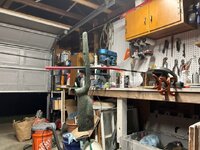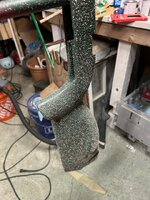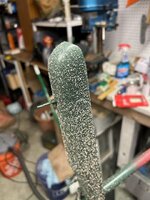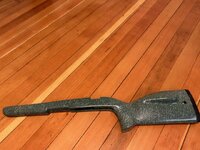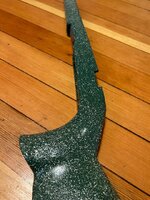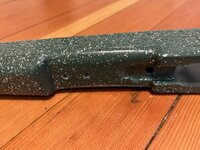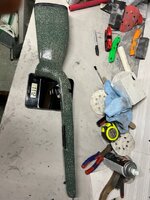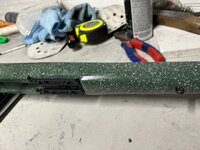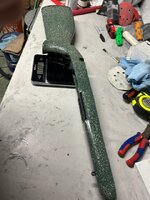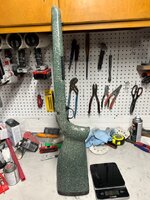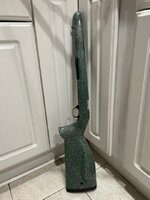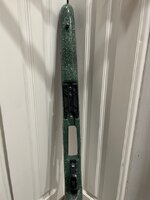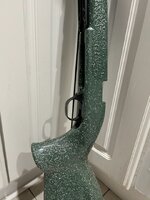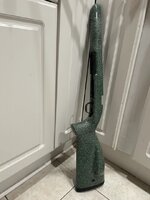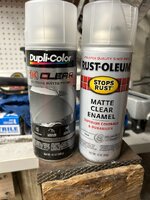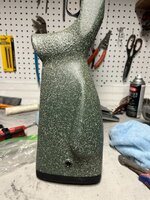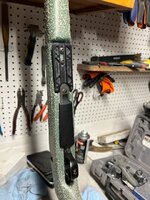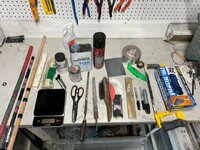I wanted to do a project summary while I’m waiting to get the barreled action bolted up.
Overall, I would say this is not a beginner project, but only barely into intermediate territory. Take your time, pay attention to details, and it’s very straightforward. With very basic hand tools, good quality fabric and resin, and patience a carbon fiber stock is easily in reach.
Here are the main tools I used:
View attachment 608911
From L to R:
- some dowels and PEX/PVC/metal pipe: used for aligning my bedding blocks when bonding into the stock skin. Also used as round sanding blocks for the barrel channel
- baking scale: (borrowed from my wife): both the epoxy resin and Marine Tex stated to mix by volume, but I mixed by weight and didn’t see any problems
- woods shims work great for mixing epoxy and applying Marine Tex
- acid brushes: just the cheap ones work great for applying epoxy resin
- Marine Tex: I bough the larger kit and used almost all of it during my few iterations of bedding blocks. It’s thicker than resin which can be helpful, and dries very tough but can still be shaped with files/sandpaper. Nice to have because if you make a mistake and cut/gouge/sand too deep, you can always build it back up with this stuff.
- epoxy resin: I used West System 105 resin with 206 slow hardener. I didn’t bother with the calibrated dispensing pumps because they only work with the larger container of hardener. I’ll have to look and see if I can get a slower hardener, as more time really would have helped. I got this stuff because it was (relatively) inexpensive and readily available from my local West Marine, and it worked great.
- scissors: use good ones on CF/fiberglass and not the cheap/dull ones shown, although they did work
- spray adhesive: I used 3M super 77 to join the foam sheet pieces together. It didn’t work great on the rougher white foam, but on the smooth-surfaced green sheets, it was strong and never delaminated
- assorted files: I shaped the majority of the foam form with just these two files. If I had a half-round file I think I would have shaped the entire foam plug with files. They work well on the foam; rigid to keep everything straight and not too aggressive
- wire brush: used as a file card to keep the files clean from the resin build-up
- sandpaper: I used sandpaper wrapped around a skinny and a fat sharpie to shape the rounded sections of the foam plug and pretty much all shaping between CF layers and the final surface finish
- utility knife with sharp blades: works well for cutting thin areas of foam, trimming the razor sharp edges of cured CF fabric, and many miscellaneous jobs
- tape: mainly for masking, but also holding forms during basic layups. I used insulation foil tape for the sole reason of it is what I had near my workbench. Electrical tape also works nice as it has some stretch
-hacksaw: works phenomenal for cutting foam; even on gentle curves
- gloves: need lots of gloves for working with CF and epoxy resin
I used a few power tools, and only briefly:
- a drill press to drill the action screw and Arca mounting holes perpendicular
- a small drill burr tip to shape a few corners of the CF inletting
- a Worksharp knife sharpener as a small belt sander to contour the grip area, but the hand tools just worked better
Lessons Learned:
- like
@Gobber stated before I started: go 1 layer at a time. It will yield a much better product with much less frustration. I tried 2 layers at a time and with the epoxy working time, more than 1 layer laid well wasn’t realistic for my skills
- I wish I would have given more thought to the design of my stock in regards to laying up the CF. Some of the curves are aesthetic only, and the layup could have been much easier and cleaner if omitted
- I wouldn’t use CF sleeve material - the sleeve didn’t conform well to compound curves
- the sandpaper I used was discs for an oscillating sander. The holes in the discs would catch and tear the foam when wrapped around a round sanding block. Just use plain sandpaper sheets
- in my first foam core I laminated pieces of construction paper between the two center sheets of foam to serve as an easy-to-see centerline. I didn’t do it with the green core, but the printed lettering on the foam sheet was visible at the joint for a centerline
Overall, this was a super fun project. I’m happy (although not 100% satisfied) with the finished product, and already want to make another!


